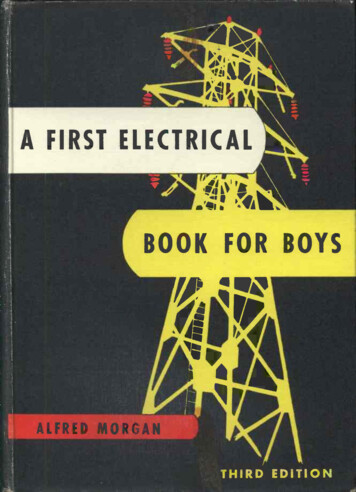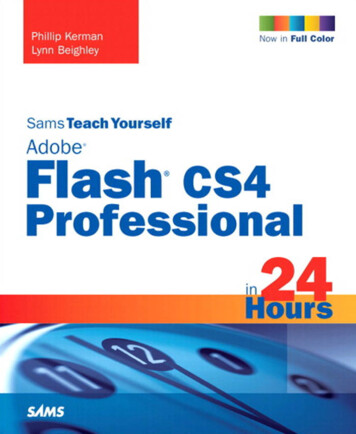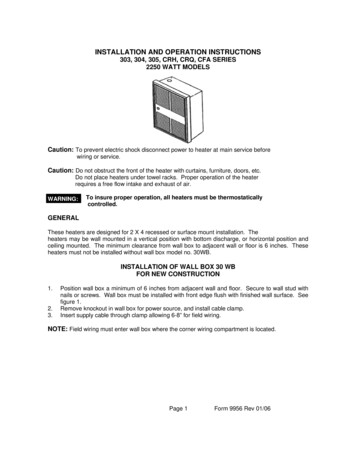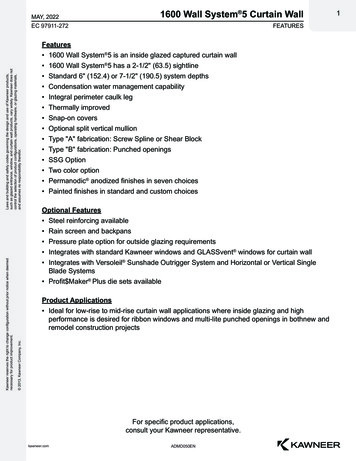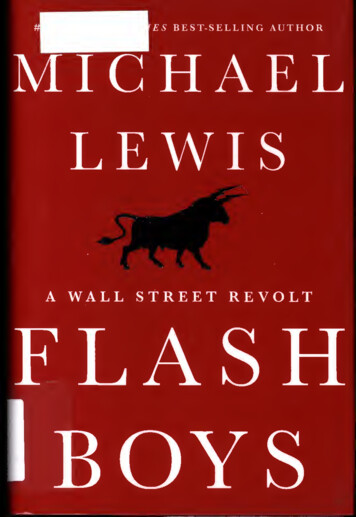
Transcription
ES BEST-SELLING#AUTHORMICHAELLEWISAWALL STREET REVOLTFLASHIBOYS
USA 27.95ISBN 978-O-393-24466-3CAN. 32.95Four years after#1hisbestsellerThe BigShort Michael Lewis returns to Wall Streec,report on a high-tech predator stalking theequity markets.Flash BoysStreet guysisabout a small group of Wallwho figureout that the U.S. stockmarket has been rigged for the benefit ofinsidersandthat, post-financial crisis, themarkets have become not more free butless,and more controlled by the big WallStreetbanks. Working at different firms, theycometo this realization separately; but after theybanddiscover one another, the flash boystogether and set out to reform the financialmarkets. This they do by creating an exchangeinwhich high-frequency trading—source of—have nothe most intractable problemswilladvantage whatsoever.The characters in Flash Boysare fabulous,each completely different from what youthink ofwhen youthink “Wall Street guy.”away from jobsSeveral have walkedfinancial sector that paiddollars a year.Fromtheirthemin themillions ofnew vantagepointthey investigate the big banks, the world’sstock exchanges,and high-frequency tradingfirms as they have never been investigated,and expose the many strange new waysWall Street generatesthatprofits.The light that Lewisshines into the darkes’corners of the financial worldmaynot be(continued on back flap)
APR2014
FLASHBOYS
ALSO BY MICHAEL LEWISBoomerangThe Big ShortHome GameThe Blind SideCoachMoneyballNextThe Neu New ThingLosersPacific RiftThe Money CultureLiar’sPokerEDITED BY MICHAEL LEWISPanic
MICHAEL LEWISFLASHBOYSA WALL STREET REVOLTW. W.NORTON & COMPANYNew York London
Copyright 2014 by Michael LewisAll rights reservedPrinted in the United States of AmericaFirstEditionFor information about permission to reproduce selections fromwrite to Permissions, W.W.500FifthNorton&Company,New York, NYAvenue,thisbook,Inc.,10110For information about special discounts for bulk purchases, please contactW.W. NortonSpecial Sales at specialsales@wwnorton.com or800-233-4830Manufacturing by Courier WestfordBookdesign by ChrisWelch DesignProduction manager: Julia DruskinISBN 978-0-393-24466-3& Company, Inc.New York, N.Y. 10110W.W. Norton500FifthAvenue,www.wwnorton.comW.W. NortonCastle House,& Company Ltd.75/76 WellsStreet,London1234567890W1T 3QT
A man gottohave a code.— OmarLittle
CONTENTSINTRODUCTIONWINDOWS ON THE WORLDCHAPTER1HIDDENCHAPTER2BRAD’S PROBLEMCHAPTER3RONAN’S PROBLEMCHAPTER4TRACKING THE PREDATORCHAPTER5PUTTING A FACE ON HFTCHAPTER6CHAPTER7AN ARMY OF ONECHAPTER8THE SPIDER AND THE FLYEPILOGUEIN PLAIN SIGHT17235689128HOW TO TAKE BILLIONS FROM151WALL STREET193244RIDING THE WALL STREET TRAILAcknowledgments273
FLASHBOYS
INTRODUCTIONWINDOWSON THE WORLDsupposethisbookwhenstartedI firstheard the story ot Ser-gey Aleynikov, the Russian computer programmerIworkedforGoldmanafter he’d quit his job,the United Statescomputer code.inSachs and then, in thethoughtstealingGoldmansortGoldmanrole, that thewho had been charged with anyemployee who had taken something fromSachs employeeof crime was theGoldmanSachs’sstrange, after the financial crisis,itwhich Goldman had played such an importantonlyhadwas arrested by the FBI and charged bygovernment withI’dwhosummer of 2009,Sachs. I’d thoughtiteven stranger that governmentprosecutors had argued that the Russian shouldn’t be freed onbailbecause theGoldmanSachs computer code, in thewronghands, could be used to “manipulate markets in unfair ways.”(Goldman’s were the right hands? If Goldman Sachs was able tomanipulate markets, could other banks dothe strangest aspect of the casebe—for thefewwhowas howattempted—it,too?)difficultto explainitBut maybeappeared towhat the Russian
FLASH BOYS2had done.Idon’tmean only what he had done wrong:what he had done. His job. He was usually describedmeanI“high-as afrequency trading programmer,” but that wasn’t an explanation.That wasterm of artaeven on WallWhyfrequency trading?Sachs to doitsummer of 2009, mostthat, in thehad never before heard.Street,was the codewhenso important that,itpeople,What wasthat enabledwas discoveredtobeen copied by some employee, Goldman Sachs neededFBLtheItcode wasthisonforGoldmanhaveto callonce so incredibly valuable and soatdangerous to financial markets,workedhigh-GoldmanhowdidRussianawho hadSachs for a mere two years get his handsit?At some pointIwent lookingMythose questions.forsomeone who might answersearch ended in aroom lookingoutattheWorld Trade Centersite,were gatheredarmy of shockingly well-informed peoplea smallfrom every cornerotatOneWall StreetLiberty Plaza. In this—big banks, the major stockexchanges, and high-frequency trading firms.lefthigh-payingjobs to declare war on WallamongroomManyStreet,of them hadwhich meant,other things, attacking the very problem that the Russiancomputer programmer had been hired by Goldman Sachscreate. In the bargain they’dIsought answersthought tothanIIask.to,along withThese,ita lotexpertsof other questionsturned out, weretartoon the questionsmoreIhadn’tinterestingexpected them to be.didn tstartitmuchout withthough, like most people,WhenbecomeIcrashed on Octoberaround thefortieth floorinterest in the stockenjoy watching19, 1987,of OneIitgomarketboom andhappenedtocrash.be hoveringNew York Plaza, the stock marketmy then employer, Salomontrading and sales department ofBrothers. That was interesting. If you ever needed proof that even
WINDOWS ON THE WORLD3Wall Street insiders have no idea what’s going to happen next onWallStreet, thereitOne momentwas.all iswell; the next, thevalue of the entire U.S. stock market has fallen 22.61 percent, andno one knows why. During thesome Wallcrash,to avoid the orders their customerswantedsimply declined to pick up their phones.thatItwasn’t thetimefirstWall Street people had discredited themselves, butthe authorities responded by changing the rulesforStreet brokers,to place to sell stocks,timethis—makingiteasiercomputers to do the jobs done by those imperfect people. The1987 stock market crashstronger over the years—weakat first,ended with computersentirelymotionset in—that hasa processreplacing the people.Overthe past decade, the financial markets havechanged toorapidly for our mental picture of them to remain true topictureI’llbet most people have of the marketshuman being mightbottom of somehave taken. IncableTV screen,it,a tickeris stilldated; the worlditdepictsisThetape runs across theand alpha males in color-codedjackets stand in trading pits, hollering at each other.islite.a picture aThat picturedead. Since about 2007, therehave been no thick-necked guys in color-coded jackets standingin tradingpits;or, iftheyare, they’re pointless.some human beings working on thefloor of theThereareNew YorkstillStockExchange and the various Chicago exchanges, but they no longerpreside over any financial market or have a privilegedthose markets.TheU.S. stock marketboxes, in heavily guarded buildings inWhatgoes on inside those black boxestape that runs across theonly thetiniest fractionpublic reports ofand unreliablebottom ofnowNew Jerseyisinsideand Chicago.hard to saycableviewtrades inside blackTV—the tickerscreens capturesof what occurs in the stock markets.what happensTheinside the black boxes are fuzzy— even an expert cannotsaywhat exactly happens
FLASH BOYS4inside them, orwhenhappens, or why.itTheno hope of knowing, of course, even theHelogs onto hishe needs to know.TD Ameritrade or E*Trade or Schwab account,symbol of someenters a tickeraverage investor haslittleHe may“Buy”: Then what?stock,andclicksan icon that saysthink he knows what happens afterhe presses the key on his computer keyboard, but, trust me, hedoes not. If he did, he’d think twice before he pressedThe worldbecauseit’sclings tocomforting; becausewhat has replacedforyou have nodraw— ofThecomingataso.builtisWalldrawStreet;This bookup ial world,takesdrawofitan attempt tobunch of smallerbehave impersonally inpersonally; ofathan they hadCanadian, of all thingsmanymy breathandto—standssmaller pictures intocoherent whole. His willingness to throw open aAmericantokinds of financialticks rather differentlyitof these peoplethe picture’s center, organizing thethea pictureWall Street with one idea of what makes theplace tick only to find thatsupposed.so hard toprogrammer himself would never dothat thepeople,doingpicturepost-crisiscleverness; of computers,waysit’sand because the few people ableinterest inthat picture.picturesit;it.old mental picture of the stock marketitswindow onshow people whatithasaway.As does the Goldman high-frequency trading programmerarrested for stealingforGoldmanGoldman’s computer code.Sachs, Sergeysecond floor of OneAleynikov hadNew YorkaWhenhe workeddesk on the forty-Plaza, the site of the oldSalomonBrothers trading floor, two floors above the place I’d once watchedthe stock market crash.Hehadn’t been anystaying in that building than2009, hadwas onleft1had been and,from ChicagotoNewark,interested inin thesummer ofOn July 3,New Jersey,to seek his fortune elsewhere.a flightmore2009, heblissfully
WINDOWS ON THE WORLDunaware ofhis place in the world.happenwhat was abouttohe had no ideahowtolanded.of knowingThenagain,high the stakes had become in the financialmagnitude of thosewindow of hisHe had no wayhim when hegame he’d been helping Goldmanto see the5airplane,Sachs to play.stakes,down ontheOddly enough,he had only to look out theAmerican landscape below.
CHAPTER ONEHIDDEN IN PLAIN SIGHTBmeny the summer of 2009 the line had a life of its own, and twothousand men were digging and boring the strange homeitTwo hundredneeded to survive.andfiveeach, plus assorted advisors and inspectors,early to figure outhowcrews of eightwerenowrisingthrough some innocentto blast a holemountain, or tunnel under some riverbed, or dig a trench besideacountry road that lackedinch-wide hard black—a roadside-Why? Thethe obvious question:plasticititsburrowstraight path evercenterernpeculiar needs and wants.maybeinto the earth.ItAboveprincipal data centeritsto be straight,on the South Side of Chicago*New Jersey.Thedugjust a one-and-a-half-already had the feeling of a livingcreature, a subterranean reptile, withneededwithout ever answeringtube designed to shelter four hundredhair-thin strands of glass, butItallwaslinewasall,laterto a stockapparently,movedthe most insistentlyneededitto connect a dataexchange in north-neededtobeto Aurora, Illinois, outsidea secret.Chicago.
FLASH BOYS8The workers werewhat they neededtold onlytoknow. Theytunneled in small groups apart from each other, with onlylocal sense otgoingtoThey wereto.makewhere thespecifically not toldYeah,just said,Iof theitawaspurposeline’ssure they didn’t reveal that purpose to others. “All thetime, people are asking us,ment?was coming from or wherelinenot haveknown whatenemies:Theyall’the govern-for,but theyknewthatithadto be alert to potential threats. If theyline, for instance,of questions abouta lotIs itone worker. The workers mightthe line wasknewsaw anyone digging near theone askingthis top secret?‘Issaidor noticed any-they were to report whatit,they’d seen immediately to the head office. Otherwise they wereto say aslittle assay, “Justlaying fiber.” That usually endedthe conversation, but if it didn’t,struction crewsthem what they werepossible. If people askeddoing, they were towereasitThe con-didn’t really matter.bewilderedasanyone.They were usedto digging tunnels that connected cities to other cities,ple to other people. This line didn’t connectelse. Its solepurpose,as possible,evenmountainif thatmeant they hadflirtingrocksaw throughway aroundit.aWhy?with another depression andthey were just happy for the work. Asknew why.anyoneas straightmost workers didn’t even ask theuntil the end,The country wastoand peo-tothey could see, was to berather than take the obviousRight upquestion.as far asanyonemakePeople began toDanSpiveysaid,“No onetheir reasons up.”Spivey was the closest thing the workers had to an explanationbed they were digging for it. And Spivey wasby nature tight-lipped, one of those circumspect southerners withfor the line, or themore thoughts than he caredto share.He’d been born andin Jackson, Mississippi, and,on thosesoundedHe’d just turnedas if hed neverleft.rare occasionsraisedhe spoke, heforty butwasstill as
HIDDENIN PLAIN SIGHTlean as a teenager, with the face of aAftersomeunsatisfying yearsson he’d quit,he putasworkingturned out to be rentingmoreownfor hismadehow much moneytrading futures contracts in Chicago against thepresent prices of the individual stocks trading inNew Jersey.atit.To captureonce.In the old daysfloors—before, say,human2007—limits.if youfor instanceyou hadthe profits,of the exchanges, and“fast”constraint wasthe data center inin Carteret,Whatbothrapidly.whicha traderthe speed withbeings worked on thewantedtobuy orsellanythingThe speed with whichhow fast an electronic signal could nhoused the Chicago Mercantilea data center beside theNasdaq’s stock exchangeNew Jersey.Spivey had realized, by 2008, was that there wasdifferencebetween the trading speedwasthatthese exchanges and the trading speed thatsible.to be fast towas changingon them was no longer constrained by people.between Chicago andExchange andsellthrough them. The exchanges, by 2007, wereto passtrades occurredyou couldHumansimply stacks of computers in data centers.The onlyYork andthe price of the stocks thatWhat was meant bycould execute hadyou had—when,more thanthe futures contract formarketsNewEvery day there were thousands of moments whenthe prices were out of whackcomprisedThataccount. Like everyother trader on the Chicago exchanges, he sawcould besporting.”on the Chicago Board Optionsa seatExchange and making marketsstockbroker in Jack-as a“to do somethingit,9Walker Evans tenant farmer.Given the speed of light insible for a traderwho neededfiber,itto trade insend his order from Chicago toNewavailableabigbetweenwas theoretically pos-should have been pos-both placesYork and back12 milliseconds, or roughly a tenth of the timeitatonce toin roughlytakesyouto
FLASH BOYS10blink your eyes, if you blink asisone thousandth ofous telecom carriersslower thanthat,fast asThea second.)youcan. (A millisecondroutes offered by the vari-—Verizon, AT&T, Leveland inconsistent.Oneday3,itand so on—weretook them 17 mil-liseconds to send an order to both data centers; the next,themBy16 milliseconds.across a route controlled“The Gold Route,”you happenedby Verizonbetweenontradersitit,because on the occasionsityou were thefirstprices inChicago andprices into exploitYork. Incredibly to Spivey, the telecom carriers were notto understand thefailto see thatitnew demandcouldsell itsfor speed.“You would haveyou gotlate ascialit,”says Spivey.Not onlyNewsetupdid Verizonspecial route to traders for a fortune;Verizon didn’t even seem awarevalue.tookhad stumbledthat took 14.65 milliseconds.the traders calledto find yourselfthe discrepanciessomeaccident,it“Theyowned anything ofupto orderdidn’tspecialseveral linesand hope thatknow whatthey had.” As2008, major telecom carriers were unaware that the finan-markets had changed,radically, the valueof a millisecond.Upon closer investigation, Spivey saw why. He went to Washington, DC, and got his hands on the maps of the existing fibercable routesrunning from Chicago toNew York. Theymostlyfollowed the railroads and traveled from big city to bigLeavingNew York andeach other, butwhenChicago, they ranlinemain problem:highway.asamap of Pennsylvania and sawThe only straightthe Allegheny Mountains.running through the Alleghenies was theway, and there wasThecity.towardthey reached Pennsylvania they began towiggle and bend. Spivey studiedthefairly straightainterstate high-law against laying fiber along theinterstateother roads and railroads zigzagged across the statethe landscape permitted. Spivey found aPennsylvania and drew hisownmoreline acrossit.detailed“Themap ofstraightest
HIDDENIN PLAIN SIGHTpath allowed by law,” he liked tocallit.11Byusing small pavedroads and dirt roads and bridges and railroads, along with theoccasional private parking lot or front yard or cornfield, hecould cut more than a hundred milesthe telecom carriers.obsession,muchWhat wastooft the distance traveledbecomebegan with an innocent thought:fastersomeone would beifthey didbySpivey’s plan, then hisI’d like to seehowthis.In late 2008, with the global financial system in turmoil,Spivey traveled to Pennsylvania and found a construction guyto drivehimthe length of his idealized route. Forrose together at five in the“What younight.morning and drovewhen you doseethis,” says Spivey, “issmall towns, and very tiny roads withsheer rock wallon theother.”Thetwo days theyuntil seven atcliffson onesideveryandarailroads traveling east towest tended to tack north and south to avoid the mountains:They were of limiteduse.“Anythingwest that had any kind of curve inthat wasn’t absolutely east-it Ididn’t like,” Spivey said.Small country roads were better for his purposes, but so tightlysqueezed into the rough terrain that there was no place to lay theunder the road. “You’d havefiber butto close the road to digupthe road,” he said.Theconstruction guy without of his mind. Yetcome up withapossible. That’s“Iwasdoneit,”it.reasonhimclearly suspectedhewhythe plan wasn’twhat Spivey had beensays. “Ihe might beSpivey pressed him, even he couldn’tjust trying to find the reasonblock.” Asideonewhenat leastafter: atheoreticallyreason not to dono [telecom]was thinking: SurelyI’llseecarrierfrom the construction engineer’s opinionin his rightmind wantedto cuthadsome roadthatnothrough the hard Alleghenyrock, he couldn’t find one.That’swhen,ashe putsit,“Idecided to cross the line.”The
FLASH BOYS12line separatedwho traded options on Chicagowho worked in the county agencies andWall Street guysexchanges from peopleDepartment of Transportationcontrolled publicthatofficesrights-of-way through which a private citizen might dig a secrettunnel.Hesought answers to questions:about laying fiber-optic cable?TheWhat mightalay fiber.itrecalls, “ItWhat kindwas fromwhose cousina friendising questions about casehow would youfew monthslatering in Cleveland.merwhotake?to.’sizes,said,‘IwhoAs Williamshave an oldand he has some construc”Spivey himself then called.Williams, “andrecallsand what kind ofSpivey called“I didn’ttocall.fiberisask-youuse,dig in this ground and under this river.”Williams. Spivey toldwhat he neededHeof mine.would supervise the laying of acable. InitSteve Williams,unexpectedin trouble,“This guy gets on the phone,”Along wouldof equipment was required?namedconstruction engineertion questions he needs answersandHowcost?lived in Austin, Texas, received anfriendthe rulesyards a day might a crew with the right equipmenttunnel through rock?Soonandto dig holesHow manyWhat werepermission did you need?Wall Street people from peopleline also separatedknew howWhosehimagain—to askknow whatIwas gettinghim nothing more aboutknowhimifhefifty-mile stretch of fiber, startinto,” saidthe project thanto lay a single fifty-mile stretchofbetween, Spivey had persuaded Jim Barskdale, the for-CEOof Netscape Communications and a fellow native ofJackson, to fund what Spivey estimated to be a 300 milliontunnel.They namedthecompany Spread Networks, thoughthey disguised the construction behind shell companies withdullnameslikeNortheastern ITS and JobDavid Barksdale, came on board—8.JimBarksdale’s son,to cut, as quietly as possible,
HIDDENhundred orthe fourIN PLAIN SIGHTneededso deals theyand counties in orderto13to cutwith townshipsbe able to tunnel through them. Wil-liams then proved so adept at getting the line into the groundthat Spiveyand Barksdale called and asked him to take over theentire project. “That’swayNew Jersey,’ ”towhentheyWilliams‘Hey, thissaid,isgoingtheallsaid.Leaving Chicago, the crews had raced across Indiana andOn a good day they were able to lay two to three miles ofWhen they arrived in western Pennsyl-Ohio.the line in the ground.vania they hit the rock and the pace slowed, sometimes to a fewhundredfeet a day.hard limestone.“TheyAndit’scallitblue rock,” says Williams.a challenge to getthrough.”“It’sHe foundhimself having the same conversation, over and over again, withPennsylvania construction crews. “I’d explain to them thatneed to go through some mountain, and onewouldbutsay, ‘That’s crazy.’that’sI’d say,how‘It’sAndwe’re doingit.’wouldIAndmore of a customizedTo which theyreally didn’t‘Iweanother theyknowthat’s crazy,they would ask, ‘Why?’Androute to the owner’s wishes.’muchhaveHis other problem was Spivey,slightest detours.say,afterwho wasto say except,allhim aboutover”“Oh.”theFor instance, every so often the right-of-waycrossed over from one side of the road to the other, and the lineneededto cross the roadwithinroad crossings irritated Spiveyrightandleft turns.seconds,” he’dond.)say.“Steve, you’re costing(A nanosecondAnd: “Can youat least crossSpivey was a worrier.risks,the thing thatboundaries. These constantits—WilliamsHeisitahundred nano-one billionth of one sec-diagonally ?”thought thatwent wrong waswas making sharpmewhena persontookusually a thing the personhadn’t thought about, and so he tried to think about the things hewouldn’t naturally think about.The ChicagoMercantile Exchange
FLASH BOYS14to New Jersey. The Calumet River mightSome company with deep pockets a big Wallmight dose and move—prove impassable.—mightStreet bank, a telecom carrierdoing and doitthemselves. Thatlast fearownalready out there, digging Inswhat he wasdiscover—someonethatstraight tunnelelsewas— consumedhim. Every construction person he talked to thought he was outof hismind, and yet he was sure the Alleghenies were crawl-ing with peoplewhobecomes obvioussurelysomeoneWhatished,elsehedoingthat the linetoWhatitthat,oncewould bethecameittoWhatworthline’stwenty-five different playersthe rest of the market?toin the U.S. stock market,thisa singleto share thethe degreemarket value.Howmarket toHow muchelse?tosame advantage overithelpscan make purely from speedand how,exactly, theymakeaDutch auctionit—until the linethatit.“Nomanythatstart atamonopoly.any one bank or hedge fund wouldbillions of dollars theywas worth, and theyis,was bought byWall Street firm, which would then enjoyfork over theaboutvaluable to thethese sorts of questions,tradersreserve price and lowerThey weren’t confidentolywas compli-Itit.market,” says Spivey. “It was opaque.”They considered holdingsome high—To answerknow how much moneyone knewdoto a single player in the U.S. stockhave an advantage in speed over everyoneMaybemuchknow wasthey did notfin-thought— speed—was onlyscarce.wasof a gold rush.his backers hadn’tof scarcity that would maximize themuch wassitehis lineline. Just the reverse:they were sellingwassomethingthis.”mind wasthe line until the timesellextent thatand“When“you immediately thinksaid,Wall Street would not want to buy theHe assumedcated.isnever crossed hisfor that reason, hehowshared his obsession.to you,”didn’t like theassumed the monop-sound of the inevitable
HIDDENIN PLAIN SIGHTheadlines in the newspapers: BarksdaleingOut Ordinary Americanconsultant15MakesBillions Sell-They hired anInvestor.named Larry Tabb, who had caught Jimattention with a paper he’d written calledindustryBarksdale’s“The Value of aMilli-One way to price access to the line, Tabb thought, wasfigure out how much money might be made from it, from thesecond.”toso-called spread tradebetweenNewYork and Chicago—thesimple arbitrage between cash and futures. Tabb estimated thatif a singleWall Street bank were to exploit the countless minus-cule discrepancies in price betweenThing AHeinNew York,makethey’dThingprofitsfurther estimated that there were asAChicago andinof 20 billionmanyasa year.four hundredfirms then vying to capture the 20 billion. All of themneed to be on thewere only placesBothbetween the twofastest linefortwo hundred of them oncitieswould— andtherethe line.estimates happily coincided with Spivey’s sense of themarket, and he took to saying, with obvious pleasure,“Wetwo hundredBut whatshovels for fourto charge for each shovel? “Itair,” sayswasditch diggers.”really a totalBrennan Carley, who had workedhigh-speed traders, andnetworkhundredwho had beento them. “All of uswerethey came up with was 300,000aprice of the existing telecom lines.market players willing to payleasewouldwholeased Spread’s linetheirowninwet fingerwithcloselyhired by Spivey tojust guessing.”signal amplifiers,ofsell hisThe numberThefirsttwo hundredadvance and signalsostocka five-yearThetradersneed to buy and maintainhoused in thirteen ampsitesSpread’s route. All-in, the up-front cost to each of thedred traders would come to about 14 million, orof 2.8 billion.in thea lotmonth, roughly ten times theget a deal: 10.6 million for five years.wouldhaveaalongtwo hun-grandtotal
FLASH BOYS16By2010 Spread Networksearlyhadn’t informed a singlestillAprospective customer of their existence.hadersTo maximizesomeonethatwould seekelseMarch 2010,to replicatethreesellit.and powerfulmen whose“Themodus operandi wasthese firms‘YoutosayslineHow tobusinesses theyone of us knew,”come over anduntilit isNDAsign anThat’showwewas duewere aboutto findBrennanto beapproach the richto disrupt?someoneCarley.atone of“We’dsay,The“People toldfirstmehe carried withsays Spivey.himdemanded—youwe comein stealth.to”in.’“There weretheyin the financialthem wastotal disbelief.they thought, Surely not, butlet’ssays Spivey. Anticipating their skepticism,amap, fourfeetby eighthis cross-country tunnel.proof.line buried three feetcan’t tellThe men with whomreaction of most oflater thatwalked them throughstillWemost highly paid peoplethehim anyway,”talk toyou about.And, by the way, we want youthey went to Wall StreetCEOs at every meeting,”markets.talk toget there.[non-disclosure agreement] beforemet were amongplethey decided to waitknow me. You know ofjim Barksdale. We have somethingwe wantwhata secret.what they had done,so,months before thecompleted, before they tried togeneralstillthe line’s shock value and minimize the chanceor even announce their intention to dountilyear after the work-started digging, the line was, incredibly,Youfeet.Hefinger-Even then peo-couldn’t actually see a fiber-opticunder the ground, but the ampsiteswerehighly visible thousand-square-foot concrete bunkers. Lightfades asittravels; the fainteritbecomes, thelesscapableitisof transmitting data. The signals transmitted from Chicago toNew Jerseymiles,theseandneeded to be amplified everyfor the amplifiers that did thefifty to seventy-fivework, Spread had builtmaximum-security bunkers along theroute. “Iknow you
HIDDENIN PLAIN SIGHT17guys are straight shooters,” one trader said to them. “Butheard of you before.Iwanttograph of the most recenthimthatitOnceWhatampwas actually beingtheir disbelief faded,Of coursejust in awe.glass fibers,theymy 14do I get foronesitethe lineone.)Whenissatand tickedof a long conference“SHIT, THISISaswhatcan you supply us with the fivemoveto aweatnewhimwe dorequire beforefor fifteenasa traderwhominutes on the otherdidn’t get saidwas oftenas interest-were changingfully understand.Theirinnewwaysabilitycomputer, rather than human, speed had givenclassof Wall Street traders, engaged intrading. Peoplenewhowrisekinds ofand firms no one had ever heard of were get-ting very rich very quickly without having to explainwere orbusi-they askedthen leapt to his feet and shouted,financial marketseven professionals did nottouptheir boxes, they failed to disguisetable,whatThedid.itthe backup if your line goesCOOL!”In these meetingsingif the line’s cutwill haveany firm? (Um, in five years.) But evenstone-faced listening tosidewhowonder. Spivey’s favorite meeting was withtheirshowand expenses? (TwoWhat happensyears of audited financial statements thattheir questionspho-toasked the usual questions.all stilland running in eight hours.) Whereness withabuilt.million in assorted feesisn’tmanunder constructionfor each direction.)doum? (Sorry, therethismost of the Wall Street guys were(We have people onby a backhoe ?Everyto see a picture of this place.”day for the next three months, Spivey emailedneverIthey weremakingtheirwhotheymoney: These people wereSpread Networks’ target audience. Spivey actually didn’t careto pry into theirtocomethis,”hewarring tradingacross as if wesaid.Heknew howstrategies.“Wenever wantedthey were makingdidn’t ask, they didn’t say.money onBut the response of
FLASH BOYS18manyotthem suggesteddepended on beingcommercial existencethat their entirethan thefasterof the stock marketrestand that whatever they were doing ne millionth ofwas so importanttheytheirsellisthem was nottothreatened by this fasterclear;newWethis line.ing.westrategiesAnd“I’ll tellfrommyyoulive in awhenmonth.written to the SEC.myFor 300,000mya.office.’mythey came toAnd.Whomonththingknow whofrom readingusus.couldn’tIthey were goingthe cli-a letterplus awe’dfew million more in up-frontmaking perhaps moremade on WallStreetwould enjoywhat they were already doing. “Atkind of pissedoff,” says Carley.meeting, David Barksdale turned to Spivey andpeople hateof mytakes those kinds of business risks?”people have everthat point they’d getTheofficethey didn’t eventhe right to continue doingOddly enough, Spivey lovedAfter onesaid,Thosethese hostile encoun-was goodtohave twelve guys on the other side of theand they areallmadters. “Ittable,to continuehave to be onoffice to talk to allexpenses, the people on Wall Street thensaleswereaction to them,” says Darren Mulholland,They only discoveredmoney thanwe wanthigh-speed trading firm called Hudson RiverTrading. “It was, ‘Get out ofgothathave no choice but to pay whatever you’re ask-believe was thatents were!speedwas”a principal at atowhyclear“Somebody wouldare currently running,you’r
contents introduction chapter 1 chapter2 chapter3 chapter4 chapter5 chapter6 chapter7 chapter8 epilogue windowsontheworld 1 hiddeninplainsight7 brad’sproblem23 ronan’sproblem56 trackingthepredator89 puttingafaceonhft128 howtotakebillionsfrom wallstreet151 anarmyofone193 thespide



